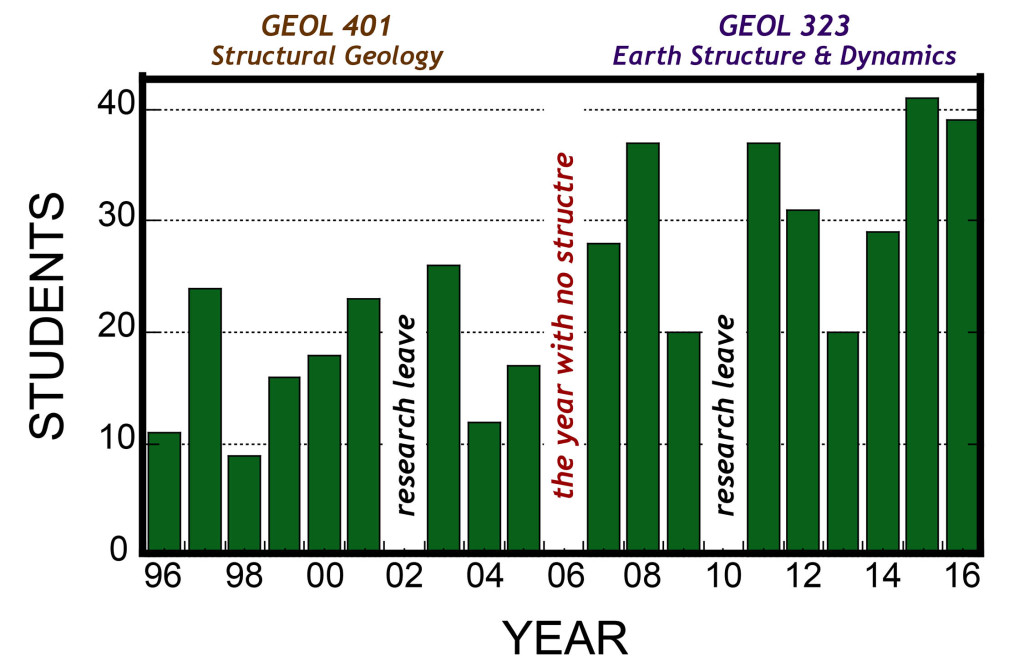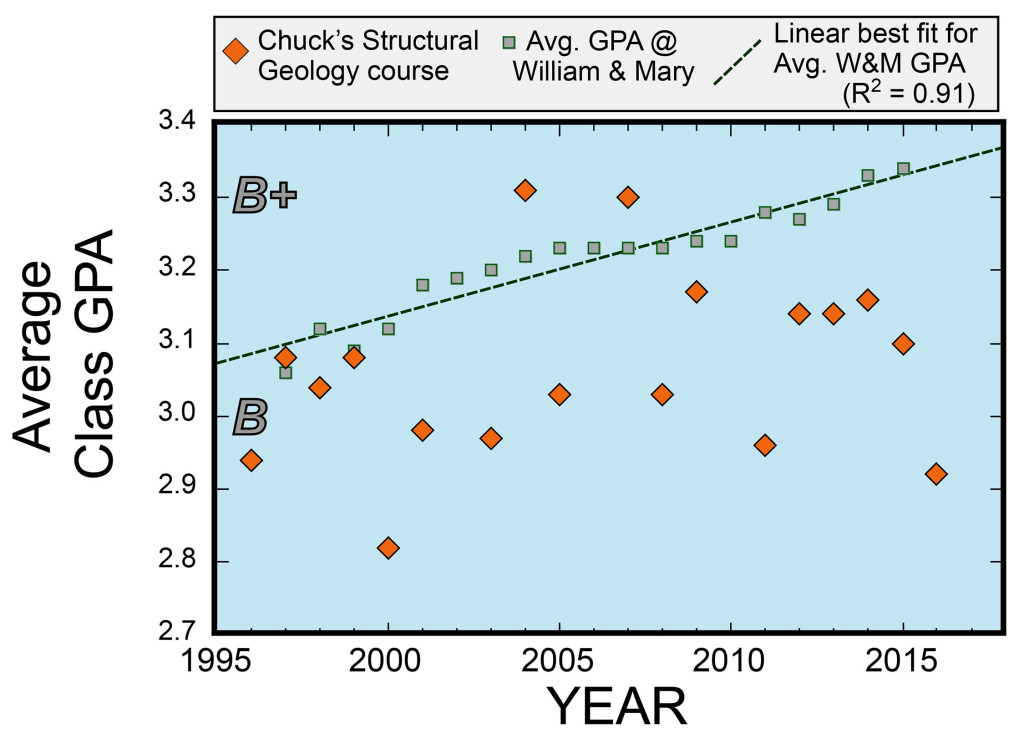‘Tis the season for grading final exams. Once the grading is complete, it’ll be time to determine who’s been naughty or nice, and dole out final course grades. In the Fall of 1996 I started teaching at William & Mary, and nearly every year for the past two decades I’ve taught a structural geology course. Twenty years on, I thought the time was right to reflect my teaching and grading: what has changed, what has remained the same, are there any long-term trends?
In the mid-1990s the course was entitled Structural Geology (GEOL 401) and was populated by junior and senior Geology majors, in 2006 we changed up our Geology curriculum and the course became a 2nd-level geology course entitled Earth Structure & Dynamics (GEOL 323). In total, 439 students have completed either GEOL 401 or GEOL 323. As the graph below illustrates enrollment has grown in recent years; that follows as Geology has more majors than ever before.

Has my grading changed? Has the course become easier or harder over the years? The plot below illustrates the average class GPA per year (orange diamonds); the long-term average for the course is a 3.07 (on the traditional 4 point scale). This is the average GPA for the whole class, some students earn a better grade and others earn a worse grade. Overall, the average grade is a B, although in the best years it has topped out at 3.3 (a B+ average), and in some years it has dipped down to nearly 2.8. From year-to-year, and from class-to-class, the average grade bounces around quite a bit, and I do not discern any long-term trend. Put another way, the grades in my structural geology course are about the same now as they were in the late 1990s.

The graph also shows the average GPA at William & Mary; in 2000 the average W&M GPA was a 3.1 and in 2015 it was just over 3.3. There is a distinct upward trend to the average W&M GPA. It’s interesting to speculate on the causes of this trend: perhaps William & Mary students are smarter than ever and earning better marks. Or perhaps this trend is a reflection of grade inflation at William & Mary. Based on the linear best fit for these data (the dark green dashed line), I’d predict that the cumulative W&M GPA will top out at 4.0 (i.e. everybody gets an A) in the 2060s!
Regardless, in most years my structural geology course grades fall below the William & Mary average. The course’s reputation, among geology majors, is that of a difficult and work-intensive class. The case could also be made that I’ve not improved as a teacher in two decades (as illustrated by the lack of any upward trend in the course GPA). I’ve got many better tools to help me teach effectively (for example – my class presentations are archived and digitally accessible to students throughout the semester – that was not the case in the old days, now we regularly make use of powerful visualization tools such as Google Earth, Gigapans, and other computer programs), so perhaps I’m getting worse! That’s a sobering thought.
Let’s look at these data in another way – consider the distribution of As, Bs, and Cs (or below) over the years. For reference, at William & Mary in 2014: 50% of the grades assigned were As, 31% were Bs, and 9% were Cs. In my structural geology class approximately, 60 to 70% of the students earn Bs, and that’s been consistent since the beginning. However, the percentage of A grades from year-to-year is variable (minimum of 9%, maximum of 36%), and generally the percentage of C grades (and worse) has declined.

I attribute the decline in Cs (and worse) to an increased emphasis on collaborative group assignments. In 1996 30% of the course grade was determined by group work (primarily the mapping project and lab exercises), and by 2016 40% of the course grade was based on group work. Nowadays in-class participation, basically showing up to class and being involved in class activities, also counts towards one’s grade. For students that struggle on exams and problem sets, the collaborative work helps ameliorate their final course grade.

What to take away from this reflection? I’d like to think that my standards and expectations as to what constitutes quality work have not changed appreciably during my time at W&M. It’d be interesting to see if there are trends in other Geology courses and more broadly across the Arts & Sciences. When I teach Earth Structure & Dynamics in the spring, I’m going to show these data to the 2017 class. Perhaps these graphics will give students a better sense of my expectations and what lies ahead in the class.
I’m more than halfway through my career, but I still get excited about teaching structural geology. Every year I want to transfer that enthusiasm to my students. I’m also proud of the numerous students, who both survived and thrived in my structural geology course, and continued on to both the graduate and professional level studying the structure of the Earth.

Leave a Reply